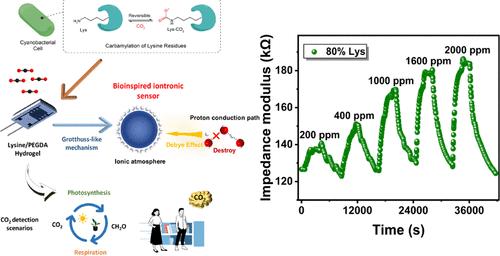Bioinspired Iontronic Gas Sensor for Selective CO2 Sensing via Reversible Lysine Carbamylation
IF 9.1
1区 化学
Q1 CHEMISTRY, ANALYTICAL
引用次数: 0
Abstract
Carbon dioxide (CO2) is ubiquitous in both natural and indoor atmospheres, playing a pivotal role in global climate regulation, air quality, and biological processes. However, their chemical inertness poses inherent challenges for developing compact, high-sensitivity detection platforms. In living organisms, CO2 often modulates protein function through reversible carbamylation of lysine residues, illustrating a finely tuned molecular recognition mechanism. Inspired by this principle, we developed a bioinspired iontronic sensor by embedding lysine moieties into a cross-linked poly(ethylene glycol) diacrylate (PEGDA) hydrogel. Upon exposure to CO2, the lysine ε-amino group forms transient carbamate adducts, inducing the electrostatic interaction, which disrupts Grotthuss-like conduction pathways and causes a distinct impedance increase. This lysine-based recognition enables high selectivity over interfering gases and operates reliably under ambient conditions. The resulting hydrogel sensor exhibits excellent linearity (R2 > 0.995) from 0 to 2000 ppm of CO2, with a theoretical detection limit of ∼76 ppm, suitable for indoor and ambient atmospheric CO2 monitoring at low concentrations. Furthermore, it maintains stable performance over at least 28 days of repeated measurements and shows negligible cross-sensitivity toward common interfering gases (e.g., H2S, CH4, and formaldehyde). By harnessing lysine–CO2 carbamylation within an ion-conducting matrix, our approach provides a versatile, low-power platform for precise CO2 sensing in applications ranging from indoor environmental evaluation to plant-level respiratory monitoring.

通过可逆赖氨酸氨基甲酰化选择性CO2传感的生物启发离子电子气体传感器
二氧化碳(CO2)在自然和室内大气中无处不在,在全球气候调节、空气质量和生物过程中发挥着关键作用。然而,它们的化学惰性给开发紧凑、高灵敏度的检测平台带来了固有的挑战。在生物体中,CO2经常通过赖氨酸残基可逆氨甲酰化来调节蛋白质功能,说明了精细调节的分子识别机制。受这一原理的启发,我们通过将赖氨酸部分嵌入交联聚乙二醇二丙烯酸酯(PEGDA)水凝胶中,开发了一种生物启发的离子电子传感器。当暴露于CO2时,赖氨酸ε-氨基形成瞬态氨基甲酸酯加合物,引起静电相互作用,从而破坏grotthuss样传导途径并导致明显的阻抗增加。这种基于赖氨酸的识别使干扰气体具有高选择性,并在环境条件下可靠地运行。所得水凝胶传感器在CO2浓度0 ~ 2000 ppm范围内具有良好的线性关系(R2 > 0.995),理论检出限为~ 76 ppm,适用于低浓度的室内和环境大气CO2监测。此外,它在至少28天的重复测量中保持稳定的性能,对常见干扰气体(如H2S、CH4和甲醛)的交叉灵敏度可以忽略不计。通过在离子传导基质中利用赖氨酸-二氧化碳氨甲酰化,我们的方法为从室内环境评估到植物级呼吸监测的应用提供了一个多功能,低功耗的精确二氧化碳传感平台。
本文章由计算机程序翻译,如有差异,请以英文原文为准。
求助全文
约1分钟内获得全文
求助全文
来源期刊

ACS Sensors
Chemical Engineering-Bioengineering
CiteScore
14.50
自引率
3.40%
发文量
372
期刊介绍:
ACS Sensors is a peer-reviewed research journal that focuses on the dissemination of new and original knowledge in the field of sensor science, particularly those that selectively sense chemical or biological species or processes. The journal covers a broad range of topics, including but not limited to biosensors, chemical sensors, gas sensors, intracellular sensors, single molecule sensors, cell chips, and microfluidic devices. It aims to publish articles that address conceptual advances in sensing technology applicable to various types of analytes or application papers that report on the use of existing sensing concepts in new ways or for new analytes.
 求助内容:
求助内容: 应助结果提醒方式:
应助结果提醒方式:


